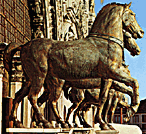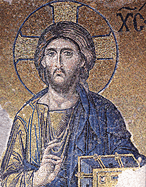 |
|
 |
Constantinople
 he capital of the Empire
he capital of the Empire
 retained very few visible marks of the short period of Latin occupation (1204-1261). Documents of the time inform us of the surrender to the new rulers of certain monasteries, such as the Pantokrator monastery, the burial place of the
Komnenoi, which was ceded to
the Venetians. They also record the attitude of the Westerners towards the works of art and the holy relics of the Capital. These precious objects were carried off to the West, to enrich the treasuries of cathedrals and private collections. A typical example is that of the four bronze horses, which used to adorn the entrance of the Hippodrome in Constantinople and which today stand above the entrance of St. Mark's in Venice. retained very few visible marks of the short period of Latin occupation (1204-1261). Documents of the time inform us of the surrender to the new rulers of certain monasteries, such as the Pantokrator monastery, the burial place of the
Komnenoi, which was ceded to
the Venetians. They also record the attitude of the Westerners towards the works of art and the holy relics of the Capital. These precious objects were carried off to the West, to enrich the treasuries of cathedrals and private collections. A typical example is that of the four bronze horses, which used to adorn the entrance of the Hippodrome in Constantinople and which today stand above the entrance of St. Mark's in Venice.
Among the few cases of buildings that underwent certain changes during this period, is the well-known
Kalenderhane Camii,
which preserves its wall paintings depicting the life of St Francis of Assisi. These representations follow Western iconographic models and were probably created by a Western artist, familiar with and influenced by Byzantine art. This ensemble, although fragmentary, is extremely important, as it is one of the earliest examples of an iconographic representation of the life of the Saint, who died in 1228.
The mosaic composition of the
Deesis
in the south gallery of the church of Hagia Sophia is the first work that is situated chronologically after the recovery of Constantinople by the Byzantines in 1261.
 According to certain views, it may have been an offering of Michael VIII Palaiologos as an expression of gratitude for his victory and the recovery of the city. The profound sense of the human form and a possibly conscious revival of classical models, elements that characterise the work, are probably connected to the general atmosphere prevailing after the recovery of Constantinople. According to certain views, it may have been an offering of Michael VIII Palaiologos as an expression of gratitude for his victory and the recovery of the city. The profound sense of the human form and a possibly conscious revival of classical models, elements that characterise the work, are probably connected to the general atmosphere prevailing after the recovery of Constantinople. In the Capital are also found the first examples of the new style in painting that would be dominant in art until about 1300.
These are a series of wall paintings in the martyrion of St Euphemia, which depict scenes from the life of the Saint. These frescoes are dated to 1280-90 and constitute a stage in the evolution of the volume style. The apex of this style is found in the Vefa
Kilisse Camii.
In the centre of the southern dome of the
exonarthex
the Virgin is depicted as Brephokratousa ("holding the Christ Child"), while, on the sides of the dome are represented eight prophet-kings of the House of David, the royal house of which Jesus was a descendant. The theme refers to the genealogy of Christ, which, like the
Tree of Jesse
and other related subjects, was particularly popular during this period. The massive forms in their ample garments are a typical example of the volume style.
At the same time, in the years after the recovery of the City and until the end of the 13th century, the restoration of older monuments and the additions to them of new buildings are very common. Thus, for instance, the widow of
Michael VIII Palaiologos,
Theodora, added to the monastic complex of
Lips
the south church, to serve as a funerary chapel. This trend was to continue during the next century and is characteristic of the new aristocratic class, who, not possessing the means to finance great works, added instead small buildings to those already existing and decorated them with particular taste and elegance.
|